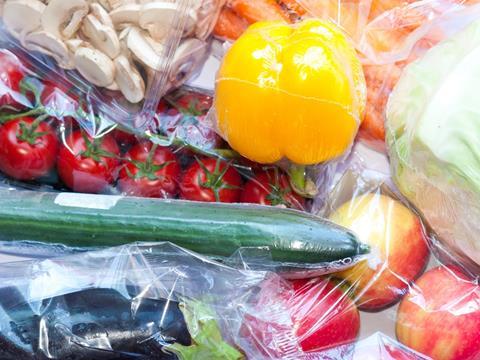
At the Fruit Logistica trade fair in Berlin, key players from fruit and vegetable supply chain organizations came together to warn against the singling out of fresh produce in blanket plastic bans – instead supporting a ‘non-ideological, data-driven’ approach to the Packaging and Packaging Waste Regulation.
As the final stages of negotiations regarding the legislation draw closer, members of Pro Food – a coalition of fresh food packaging producers in Europe – held a round table discussion titled ‘The European Packaging Regulation: Benefit or damage for the fruit and vegetable supply chain?’ Its speakers brought their own perspectives and experiences to the discussion surrounding the upcoming measures.
As suggested in a recent legal assessment, IK Industrievereinigung Kunststoffverpackungen’s general manager, Martin Engelmann, argued that, without an objective justification for doing so, banning plastic packaging alone could violate the EU’s principle of equal treatment.
“In this regard, the EU legislator has a margin of discretion, but with certain limits,” he said. “In particular, it must take into account all available scientific facts and data. Data and factors that in the case of PPWR have not been properly analyzed through a serious and thorough impact assessment.”
Freshfel Europe’s delegate general, Philippe Binard, argues that the Regulation’s emphasis on the fruit and vegetable sector does not reflect the true impact of its packaging.
“In fact, packaging for fresh produce accounts for only 1.5 percent of all food packaging currently used in the EU,” he said. “Moreover, about 50 percent of fruits and vegetables are already sold in bulk, showing that the market has already optimized as much as it could be.
“The proposal to avoid single-use plastic packaging for fresh fruits and vegetables denotes policy inconsistency, generating increased food waste and limiting the use of post-harvest treatments for better preservation of produce, which require to be done within specific packaging.”
Similarly, Ortofrutta Italia president Massimiliano del Core voiced his disapproval of the Regulation’s ban on plastic packaging only for fruit and vegetables. Especially where exports are concerned, he underlined the importance of plastic packaging when it comes to food preservation and prolonging shelf life.
He asserted that “packaging is a tool to combat food waste, which occurs 70 percent after purchase by end consumers. No less important, finally, is the role that packaging plays in enhancing the value of fruit and vegetables in the markets through the communication of product characteristics and origin. The regulation should focus on end-of-life management to incentivize recycling.”
Nor is it only European legislation that is feared to cause damage to the fruit and vegetables supply chain. Daniel Duguay, sustainability specialist at the Canadian Produce Marketing Association (CMPA), has a similarly cautious outlook on the federal Ministry of Environment’s proposal, in which 75% of fruits and vegetables should be sold in bulk or in plastic-free packaging by 2026. This figure is projected to rise to 95% by 2028.
According to CMPA’s own studies, these targets would not benefit the sustainability of Canada’s fresh produce supply chain.
“Rather, more space should be given to closing structural gaps for the realization of a true circular economy,” Duguay explained. “Attention should be given to educating consumers about the role that primary packaging plays in food: the value of packaging is largely unperceived when you consider that 90 percent of its function is performed before the consumer sees it on the store shelf.”
Yet the Packaging and Packaging Waste Regulation’s current legislative measures could undermine 32,000 jobs in Italy alone, warned Luigi Scordamaglia, CEO of Filiera Italia and president of Eat Europe.
He stated: “On the one hand, the EU invests funds in promoting the consumption of healthy foods of which fruit and vegetables are central, and on the other hand, by eliminating packaging, it prevents the very promotion of these products while also increasing food waste.”
According to Luc Vanoirbeek, chairman of the F&V working group of Copa-Cogeca, the proposed laws are not yet ‘fair, realistic and affordable’. He hopes to open a ‘more reasonable dialogue’ with the next Commission.
“Packaging is an essential factor in the fruit and vegetable supply chain with very important functionalities even if not always obvious to the consumer,” Pro Food president Mauro Salini commented. “The elimination or replacement of plastic packaging must be evaluated with scientific data not only of the packaging itself but also of the impact on logistics and content.
“Then, when we talk about the sustainability of packaging, the approach should be holistic and consider not only the environmental aspect but also the economic and social.”
He concluded that ensuring sustainability for fruit and vegetables packaging is more complex than blanket bans, and highlighted that the entire supply chain should be involved in developing legislation that values functionality, sustainability, and circularity in equal measure.
“In this regard, in light of the positions expressed during the round table, a common stance by all supply chain actors would be appropriate to prevent PPWR from generating further damage to a vital sector,” Salini said.
Last year, a statement released by Copa-Cogeca, Freshfel Europe, and Europatat, the European Potato Trade Association suggested that the Regulation’s ban on single-use packaging for fresh fruit and vegetables weighing less than 1.5kg would go against existing material uses and life cycle analyses. Instead, it called for ecological labelling and other more nuanced incentives and strategies.
However, a statement from Tesco published in The Grocer backed a government ban on fruit and vegetable packaging, positing that the move would ‘level the playing field’ in the fight against retail waste.
If you liked this article, you might also enjoy:
The Lidl approach to packaging sustainability
How did Brazil achieve its 100% aluminium can recycling rate – and can it be replicated in the EU?
Experts have their say on the EU’s Packaging and Packaging Waste Directive revisions
A deep dive into the most important packaging sustainability trends and solutions











No comments yet